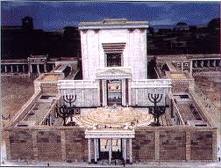
"The Light of Life"
"Then spake Jesus again unto them, saying, I am the light of the world: he that followeth Me shall not walk in darkness, but shall have the light of life."
When He spoke these words, Jesus was in the court of the temple specially connected with the services of the Feast of Tabernacles. In the center of this court rose two lofty standards, supporting lampstands of great size. After the evening sacrifice, all the lamps were kindled, shedding their light over Jerusalem. This ceremony was in commemoration of the pillar of light that guided Israel in the desert, and was also regarded as pointing to the coming of the Messiah. At evening when the lamps were lighted, the court was a scene of great rejoicing. Gray-haired men, the priests of the temple and the rulers of the people, united in the festive dances to the sound of instrumental music and the chants of the Levites.
In the illumination of Jerusalem, the people expressed their hope of the Messiah's coming to shed His light upon Israel. But to Jesus the scene had a wider meaning. As the radiant lamps of the temple lighted up all about them, so Christ, the source of spiritual light, illumines the darkness of the world. Yet the symbol was imperfect. That great light which His own hand had set in the heavens was a truer representation of the glory of His mission.
It was morning; the sun had just risen above the Mount of Olives, and its rays fell with dazzling brightness on the marble palaces, and lighted up the gold of the temple walls, when Jesus, pointing to it, said, "I am the light of the world."
By one who listened to these words, they were long afterward re-echoed in that sublime passage, "In Him was life; and the life was the light of men. And the light shineth in the darkness; and the darkness apprehended it not." "That was the true light, which lighteth every man that cometh into the world." John 1:4, 5, R. V., 9. And long after Jesus had ascended to heaven, Peter also, writing under the illumination of the divine Spirit, recalled the symbol Christ had used: "We have also a more sure word of prophecy; whereunto ye do well that ye take heed, as unto a light that shineth in a dark place, until the day dawn, and the daystar arise in your hearts." 2 Peter 1:19.
In the manifestation of God to His people, light had ever been a symbol of His presence. At the creative word in the beginning, light had shone out of darkness. Light had been enshrouded in the pillar of cloud by day and the pillar of fire by night, leading the vast armies of Israel. Light blazed with awful grandeur about the Lord on Mount Sinai. Light rested over the mercy seat in the tabernacle. Light filled the temple of Solomon at its dedication. Light shone on the hills of Bethlehem when the angels brought the message of redemption to the watching shepherds.
God is light; and in the words, "I am the light of the world," Christ declared His oneness with God, and His relation to the whole human family. It was He who at the beginning had caused "the light to shine out of darkness." 2 Corinthians 4:6. He is the light of sun and moon and star. He was the spiritual light that in symbol and type and prophecy had shone upon Israel. But not to the Jewish nation alone was the light given. As the sunbeams penetrate to the remotest corners of the earth, so does the light of the Sun of Righteousness shine upon every soul.
"That was the true light, which lighteth every man that cometh into the world."
DA 463-464